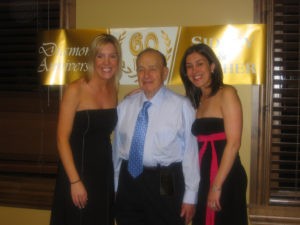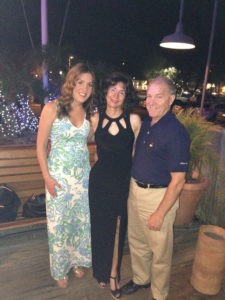That is how Harley Feldman recounts the day he found out the man who murdered his daughter, Allison Feldman, was captured three years after she was killed in her Scottsdale, Ariz., home. It was a case that confounded police and investigators from the moment they started on the case.
But what ultimately helped break the case was a chance meeting in the place you’d least expect it: On a Friends of the Israeli Defense Force mission to Auschwitz and Israel.
——————
Sid Shafner was around 20 years old when his Jeep full of reconnaissance men in the 42nd Infantry was stopped by two skinny teens on a road heading to Berlin in April 1945. The boys were saying “They’re killing people.” Shafner’s Jeep turned and end up in Dachau – and helped liberate the concentration camp. One of those boys that stopped the Jeep was Marcel Levy – a Greek Jew who stayed with Shafner’s unit and eventually moved to Israel to start and raise a family.
In 2016, Shafner was due to travel to Poland and Israel on an FIDF mission but said he would only do so if his daughter, Elayne Feldman, could come as well. He explained the tragedy of his granddaughter’s murder in February 2015.
“It was a lot (to ask), but my dad was emphatic about it,” said Elayne Feldman in a rare interview. “He knew it would help save me to get out of here.”
The trip concluded in Israel, where Levy and Shafner were reunited in May 2016, seven months before Shafner passed away at 95 years old. The trip also led to another meeting that would ultimately lead to the arrest of the man who killed Shafner’s granddaughter.
On the trip, Elayne met Barbara and Ed Leff, a couple from Scottsdale. She said that it was their daughter that had been murdered in her home, and over the course of the trip, she became close with the Leffs. Barbara Leff had been a state legislator in Arizona for 14 years, and was able to connect the Feldmans to the people in, among other places, the Arizona legislature, Governor’s Office, Arizona State Attorney General’s Office, Maricopa County Attorney’s Office, and the Department of Public Safety – which led to expanding the forensic search.
“We promised Elayne that we would be here for them every time they came here,” said Barbara Leff, who said the murder was heartbreaking and the saddest thing they’d ever heard. She introduced the Feldmans to Maria Syms, an Arizona state representative who was the former assistant attorney general.
The Arrest
The man arrested for Allison Feldman’s murder was discovered through the use of familial DNA. It’s a rarely used forensic procedure which is only legal in 12 states.
“In a family, the father and son have the same 16 (DNA) markers,” Harley Feldman said. “I got the call from the police on a Monday; the previous Thursday, the match had been made between the perpetrator and his brother, who was in jail for molestation. On Friday, the Scottsdale Police Department realized they took [the killer’s] DNA for a DUI arrest. With that, it was an exact match. That’s how quickly it happened.”
But getting to that point was a long, drawn-out process. Harley said that the Scottsdale police brought up the technology, and Syms worked to see if it was legal under existing Arizona law. The Arizona Department of Public Safety put together the procedures to use familial DNA science and chose Allison’s case to be the test case.
“I set up the meeting between Maria and Harley. And they went through every detail,” Leff said. “She talked to a lot of people. It took almost six months from the time she started until the match.”
Leff credited the Arizona Department of Public Safety for finding the resources to purchase the equipment and get the training required to run the familial DNA search that ultimately broke the case and led to the arrest.
“It’s not an easy science to learn,” Leff said. “[The Scottsdale Police Department] spent thousands of hours searching. It turned out that lucky for us that they got a match. We were shocked and thrilled and overwhelmed. If his brother weren’t in jail it wouldn’t have happened. We made a difference for not just Allison, but everyone.”
The police spent five days removing more than 400 pieces of evidence from Allison’s home. Much of it was left in ruins after the suspect used some type of chlorine to try to remove all the evidence of his having been there. There no fingerprints left anywhere, but there were three pieces of DNA recovered, which was used to match him to his imprisoned relative.
“I was so proud to be a part of this,” said Leff. “There’s no easing of pain, no peace, no comfort. No family can get that, but they can get answers. For all of us living here, even before meeting Elayne, it was terrifying to know that there was a violent individual out there. It was unnerving. We have crime, everyone does. But there’s a comfort to the community.
Harley Feldman’s Mission
Familial DNA has become the Feldman’s cause since the arrest. On July 23, Harley is scheduled to speak at the Conference of Western Attorneys General on the subject.

Allison Feldman, Sid Shafner, Kelly Feldman Weinblatt (Photo courtesy of the Feldman family).
“I’ve taken it on as a mission,” he said, adding the opponents are concerned about the procedure being an invasion of privacy.
“The way I look at, and so does the police, is that you still have to do the investigative work,” Harley said. “You still need to prove the person did the crime, and the suspect still has 4th amendment rights. It’s a path. It just gets you there quicker. I’ve taken it on as a mission.”
Feldman said that the technology was used in Minnesota in three cold cases. One case was solved but the not in the other two because there was no match.
“You have to have something in the system to match it to. There could be no match. In this case was nothing in the FBI database.”
‘Happenstance’
Sid Shafner’s persistence put his daughter on the trip – Elayne said he told the FIDF that if she wasn’t allowed on the trip, he wouldn’t be able to make it either. And sure, the Leffs have gone on several FIDF missions, but just happened to be on the one with someone they could help.
“It was happenstance,” Leff said. “[Elayne’s] dad was the was the star of the mission. Even before we got to know Elayne, we needed to something to honor Sid. If we hadn’t gone, we wouldn’t have been able to help the family of the man who helped a Holocaust survivor so many years ago.
“Just like IDF will help any community in danger, it started with us saying we’d be there for them, but we’ve become very good friends. It’s very special. Their story was very moving for us.”
Allison’s Legacy
Harley said about 300 people showed up for her funeral in Minnesota, and another 300 showed up for a memorial service in Arizona.
“I don’t know 600 people!” Harley said. “The reason 600 people showed up is that she would do things for everyone else before she took care of herself.”

Allison, Elayne and Harley Feldman. (Photo courtesy of the Feldman family).
Allison worked for the Swedish medical supply company Mölnlycke, where she sold dressings and other items for hospitals to use on burn patients and surgical patients. Shortly before her death, she was promoted to a burn specialist cover trauma centers in five states. “She’d get a call from the nurses in Tucson on a Saturday night while she was out with her friends that they needed her dressing,” Elayne said, “And she’d get in her car and drive two hours. Everybody was before her. That’s why this is all wrong.”
In addition to Harley’s work to get familial DNA search introduced more widely, the Feldmans – with the help of Allison’s friends from the University of Arizona – started an endowed scholarship to help students get financial support when they were on study abroad trips. The Feldmans point to Allison’s junior year abroad in Spain as offering huge growth opportunities for her.
“Because of that experience and her friendships with others on the trip, two friends called me last October and said they wanted to start a scholarship and asked if I wanted to get involved,” Harley said. They needed to raise $25,000 in five years to get endowed; they raised $30,000 in six months. The Allison Feldman Memorial Study Abroad Scholarships will be awarded starting in the fall.
Using her experience with burn patients, Allison worked at the Arizona Burn Foundation’s Camp Courage in Prescott, Ariz., for kids who suffered injuries from burns. Her name is inscribed on the camp’s “Wall of Champions” for her volunteer work there.
So the question continues to be: How do you go on after such a horrible tragedy?
“I don’t,” Elayne said. “I cry every day. I grieve for what she’s missed and what she can never have. I can’t go to weddings. I’ve missed four family weddings. Because it hurts me so that she won’t be the bride on the beach that she wanted to be,” said Elayne. “Her and friends used to all go out to celebrate each other’s birthdays. I was crying all day (on June 14) that she wasn’t there. Her friends sent pictures that they all went to the restaurant and set a place in her memory. Thirty-one years old and you’re a memory.
“She lost the best part of her life. It was wiped out for nothing. How do I function? I don’t.”
Said Harley: “I do it differently. I take comfort in the things I’m doing on [Allison’s] behalf. That her friends got together on her birthday is part of her legacy. In the most horrible thing, there are lessons of humanity and goodness.”

